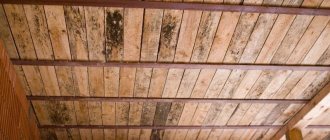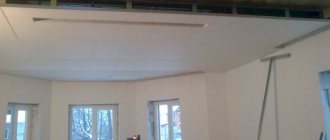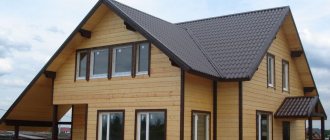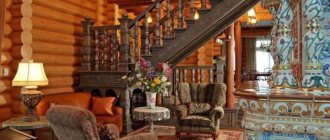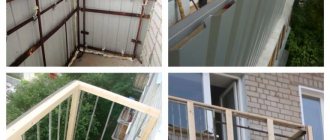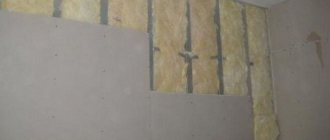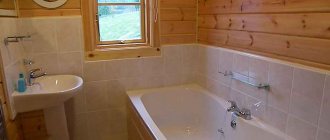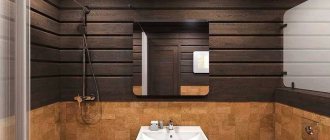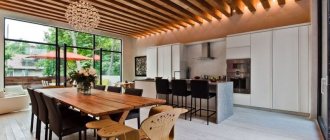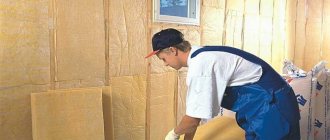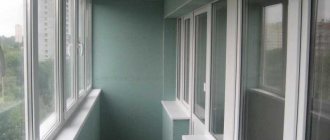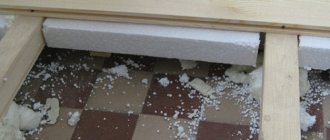The 21st century has arrived a long time ago, and wooden houses do not even think of going out of fashion. More precisely, it’s difficult to call it fashion. Rather, common sense, coupled with a subtle sense of taste, because what other natural material so organically combines environmental safety, reliability and home comfort? True, you won’t be able to escape from the interior decoration (read about how to insulate walls with polystyrene foam from the outside). This is an important component of any construction, and people often have a question: what can inexpensively and beautifully cover the inside of the walls with? Moreover, not every material is suitable for use in a wooden house. We have selected 6 excellent options for you that will definitely help you overcome your doubts and achieve optimal interior design.
- Lining;
- Drywall;
- Cork;
- Decorative rock;
- Plastic;
- Ceramic tile;
- Conclusion.
Choosing the cheaper way to sheathe a house: budget finishing options
Construction and reconstruction of a house requires considerable expenses; the acquisition of necessary materials, especially in our unstable times of constant inflation, causes significant damage to the family budget. House cladding is a special position in the design of a home; the exterior and interior decoration of a room is an indicator of the mood of the household and the respect of neighbors. The question arises of how to sheathe a house beautifully and cheaply, what materials to use to look prestigious and feel confident.
We will conduct a short information tour on inexpensive and high-quality materials to clarify the question of how cheaper it is to sheathe a house outside and inside.
Design solutions
Lining is considered a universal material that can be used in any part of the house. This lumber has an aesthetically pleasing appearance and can perfectly complement any home. You can completely decorate the house with this material or only some of its elements. And to achieve maximum harmony, you can paint the lining inside the house.
The lining can be installed in its basic condition or with paint and varnish coatings. If the lining you purchased is light in color, it can be darkened using special varnishes. There are many options for decorating surfaces, and with the right approach you can easily find ideal solutions.
Numerous photos of lining inside the house confirm how varied and beautiful the interior can be with this simple and inexpensive lumber.
Features of the choice of finishing materials
- Pay attention to the markings. The designation E1 says that the building materials are intended for residential premises, E2 - for the hallway, kitchen, toilet, utility rooms, E3 - for public and industrial premises;
- If you use finishing materials made of wood, you can choose a class and quality that is worse than required. After this, modify the products and bring them into an aesthetic appearance yourself. For example, sand and sand, varnish and/or paint, impregnate with protective compounds, trim if necessary. Thus, you will spend less financial resources than when purchasing high-class materials;
- For rooms with high humidity (bathrooms, balconies, basements, cellars, etc.), choose moisture-resistant materials. If you use wooden products, be sure to treat the products with protective agents against the negative effects of moisture, rot and mold;
- Choose eco-friendly natural materials for furnishing a wooden house. Plastic double-glazed windows or panels would look inappropriate in such a structure. They will disrupt the environmental friendliness of the house, introduce disharmony and only spoil the interior;
- Choose durable, reliable materials and do not forget about the quality of finishing work. Remember that a wooden frame gradually shrinks, which can lead to cracks. Think over this point in advance so as not to make repairs every 3-5 years and not replace damaged cladding.
More information about types of lining
On the modern market of finishing materials you can find lining made of wood, plastic and metal. Of course, wooden lining is more popular, because it is environmentally friendly, provides additional thermal insulation and has a beautiful appearance. Since wooden lining is the most popular, we will talk about it in more detail below.
The second most popular option is plastic lining. Conscientious manufacturers use high-quality plastic for its production, which is resistant to various negative influences: low and high temperatures, high humidity, etc.
This lining is perfect if there is a constantly high level of humidity in the room. Most often, plastic lining is used on balconies, loggias and in bathrooms. In some cases, exterior finishing is possible.
We recommend watching it! Finishing, insulation and glazing of balconies and loggias can be ordered on the website https://viploggias.ru/otdelka_balkonov_i_lodzhiy
Metal lining is not in high demand, but is also used for finishing some premises and external cladding of various structures. Metal panels are the most durable, so their scope of application can be very wide. However, due to its unpresentable appearance, such lining is not used in all works.
How to decorate the walls
The times of scarcity are a thing of the past. Today, construction stores amaze the imagination with a huge assortment of all kinds of materials for wall decoration, for every taste and budget.
- wallpaper, various types, colors and textures;
- decorative plaster;
- facing tiles, mosaic;
- artificial or natural stone;
- gypsum tiles;
- various wall panels.
By combining and combining these materials with each other, you can achieve excellent results, inexpensively and efficiently cover the walls.
Wallpaper - cheap and beautiful
Some people are skeptical about this type of interior wall decoration, saying that wallpaper is a thing of the past. Nevertheless, this material remains the most popular and in demand in the interior decoration of the walls of apartments, country houses and country houses.
The industry does not stand still, releasing new types of wallpaper. Along with the usual paper wallpapers, the following wallpapers appeared on store shelves:
- vinyl;
- non-woven;
- liquid;
- textile;
- bamboo;
- cork and others.
Not all of them are cheap, but you can find options for budget wall coverings.
Advice! Many stores sell wallpaper at discounted prices. These are either remnants of collections from one or two rolls, or with minor defects.
By choosing them to your taste, saving a lot of money, showing your design imagination, combining several types of wallpaper, you can cover your walls cheaply and beautifully. For example, paste wallpaper in stripes, highlight corners, borders, make panels, imitate frescoes.
Combination of different wallpapers
Advice! When choosing wallpaper, you need to take into account the style of the room, size, and lighting. For example, light colors will help visually expand the space. A small drawing will hide some wall defects.
By rummaging through the closet, asking friends or relatives, you can find the remains of wallpaper from previous renovations and use them to cover walls in country and country houses.
Cut different wallpapers into identical squares and glue them carefully in a certain order on the wall. You will get a “patchwork” of wallpaper that will look very cute and beautiful. This option is especially good for a children's room, living room, kitchen in a country or rustic style.
"Patchwork" from wallpaper
Newspapers glued to the wall and covered with varnish look very modern in the interior. Photo wallpapers look beautiful and have a very reasonable price. Wallpaper with a textured surface or for painting does not require ideal wall preparation.
Wallpapering is one of the affordable options. Anyone can handle the pasting process without professional skills.
Facing
Some interior design styles involve covering the walls with ceramic tiles or mosaics not only in the kitchen and bathroom, but also in other rooms. Several materials are used for these purposes.
- Natural stone is rare, but quite popular for fragmentary finishing in the fireplace area, doorways or on an accent wall.
- Artificial stone is a ready-made gypsum imitation, stylized as stone of various types, used not only in accent areas, but also as the main finishing material for walls, if not in the whole house, then in some rooms.
- Homemade imitation is the simplest and cheapest, and therefore a popular finish among private owners, attractive due to its accessibility and relative ease of work. Brickwork on the wall is imitated using gypsum plaster applied to the surface either through a stencil or over “seams” of masking tape. The relief is created using various available means, it can be a spatula with fingers, or a dry brush. After removing the tape or stencil and drying the “brick”, the surface is painted in one or more tones. Some also seal the seams for greater authenticity, but this is not for everyone and makes sense when the tiles are thick. Imitation of masonry is done in corridors, halls, and living rooms, and some even decorate bedrooms this way.
You can also try making an imitation using polymer molds, but this is much more expensive, but the result is practically indistinguishable from expensive collections of famous brands.
Drywall
The most versatile material that is suitable for most rooms is drywall. It is used in almost any home when it is being renovated. It is so popular due to the fact that it has many varieties, structures from it are relatively easy to construct, it has many methods and applications, and the price is quite reasonable for high-quality repairs.
When deciding how to cover the walls of a wooden house, most people remember this material, even those who are completely unfamiliar with the topic of renovation, since drywall is widely known. It’s difficult to find any flaws in him, at least we can’t do that. Read about the construction of specific structures from it on this site; here there are descriptions of any interior item that can be made from plasterboard, first of all, the ceiling and walls. Let's just say one thing: the frame on which drywall is installed can hide a lot of unnecessary things inside, and will also allow you to level the level of the walls, so its use is preferable in any room.
Tools
During all the work carried out in a wooden house, you will need the most important tool - a screwdriver. You will use it to install both the frame and the cladding layer. In a wooden house you do not need to use a drill or hammer drill, and this greatly simplifies the task of sheathing. If you don’t need to cover the entire room, and you, for example, are thinking about how to cover the ceiling in a wooden house, then it will be even easier for you, since you won’t have to buy insulation, although you can also insulate the ceiling. In addition to a screwdriver, we will need a few more tools for work, the list of which you can expand, but the most necessary ones are described here:
- Laser level, ruler, tape measure;
- Putty, spatula;
- Corners, screws;
- Notcher, drywall knife, metal scissors.
What can you use to cover the walls inside the house? The cheaper it is to sheathe walls inside a house
What is the best way to sheathe the walls inside a wooden house?
Interior decoration is an important part and the final stage of building a country house. Many people do not think about this during the construction of the foundation and installation of the log house, installation of communication systems. But when the house is already under the roof, the utility networks have been installed, the question arises of how to decorate the inside of a wooden house. Finishing “to zero” is not suitable for everyone, and it also requires special treatment of the walls with paint and varnish compounds. In addition, a house with such decoration looks empty and uncomfortable.
I want the materials to be durable, reliable, but at the same time inexpensive. And the resulting interior turned out to be cozy, comfortable and attractive. In addition, when arranging a wooden house, it is important that the products are environmentally friendly, preserve the naturalness of the structure and maintain a comfortable indoor microclimate. Today the market offers a lot of finishing materials. In this article we will look at how to cover the interior walls of a wooden house inexpensively and beautifully.
Features of the choice of finishing materials
- Pay attention to the markings. The designation E1 says that the building materials are intended for residential premises, E2 - for the hallway, kitchen, toilet, utility rooms, E3 - for public and industrial premises;
- If you use finishing materials made of wood, you can choose a class and quality that is worse than required. After this, modify the products and bring them into an aesthetic appearance yourself. For example, sand and sand, varnish and/or paint, impregnate with protective compounds, trim if necessary. Thus, you will spend less financial resources than when purchasing high-class materials;
- For rooms with high humidity (bathrooms, balconies, basements, cellars, etc.), choose moisture-resistant materials. If you use wooden products, be sure to treat the products with protective agents against the negative effects of moisture, rot and mold;
- Choose eco-friendly natural materials for furnishing a wooden house. Plastic double-glazed windows or panels would look inappropriate in such a structure. They will disrupt the environmental friendliness of the house, introduce disharmony and only spoil the interior;
- Choose durable, reliable materials and do not forget about the quality of finishing work. Remember that a wooden frame gradually shrinks, which can lead to cracks. Think over this point in advance so as not to make repairs every 3-5 years and not replace damaged cladding.
When to start
Finishing of a wooden frame can be done only after its active shrinkage has been completed. If we are talking about an old house, then proceed without fear. If the walls were built recently, it is necessary to take into account the material from which they are built:
- laminated veneer lumber - after 3-4 months;
- ordinary timber and logs - at least after 1 year.
Geometry of the house before and after shrinkage
The exact speed of completion of shrinkage depends on the climatic characteristics of the area. Air humidity and average temperature have a strong influence. It is allowed to begin finishing the internal walls made of timber and logs only after they have been caulked. Do-it-yourself work is carried out in two stages:
- The first caulking of the walls must be carried out a few weeks after the walls are assembled;
- the second is done after 6-8 months.
To caulk the walls, you will need to prepare sealing and heat-insulating material. Jute or tow is used as it. Sometimes moss can be used. Work must be carried out simultaneously from the outside and from the inside. They start caulking from the bottom. Having insulated the crown on one side, you must immediately move to the other side. Otherwise, the walls may warp.
After completion of the insulation work, the building is raised a few centimeters. Over time, the inter-crown material will become denser and the height will become the same. It is precisely due to the tight fit of jute or tow to the logs (beams) that drafts are prevented and thermal insulation performance is increased.
Caulking at home using a special cord
Read more about this in a special article about caulking wooden walls.
After the second caulking, it is necessary to periodically measure the height of the walls. If the measurement results do not change within a couple of months, the shrinkage process has stopped. In this case, you can start finishing it yourself.
Features and properties of materials for wall cladding
Various materials can be used for work inside wooden houses. Their selection is quite large. It starts with special different types of insulation, and ends with finishing materials - of natural or artificial origin.
All of them must have the following features:
- Environmental friendliness. This is a very important indicator that is responsible for the general condition of a person. Any harmful fumes are simply unacceptable.
- Reliability and durability. Of course, nothing lasts forever, but you cannot use materials that cannot last a good ten years.
- Protective properties. This includes proper heat exchange, when heat loss and cold penetration are not allowed; waterproofing and protection against static electricity.
If all these features form a single whole, then you can be sure that life in a wooden house will be cozy and comfortable.
Attention! No matter how much you would like it, if the house is completely new, then it is better to postpone any work for several months. It's all about shrinkage. Yes, it will continue to operate in the future, but it is during the first period that the most significant changes occur. Or you need to immediately take this nuance into account, leaving special gaps in the cladding being built.
Advantages of lining
In recent years, lining has become one of the most popular finishing materials, which is not at all surprising. The popularity of this material is due to a number of reasons:
- complete environmental friendliness and absence of harmful substances in wood;
- variety of wood species and varieties;
- ease of installation;
- possibility of additional sound and heat insulation;
- various decoration options;
- high strength (high-quality lining retains its ideal appearance for more than 20 years);
- low cost.
Thanks to these advantages, lining is one of the best materials for interior decoration of a house.
Laminated panels for finishing the walls of a house from the inside
One of the cheapest options for covering the walls of a private house is wall panels made of laminated plasterboard, another name for which is decorative plasterboard and gypsum vinyl panels.
Among the advantages of this coating are:
- low cost and ease of installation;
- in addition, laminated panels can withstand wet cleaning, and this is an important factor for a private country house or country house;
- panels made of decorative plasterboard look beautiful in the interior - you can choose to decorate the walls with wood, fabric or wallpaper with patterns.
Drywall has long been used for finishing walls and ceilings. But ordinary drywall requires subsequent painting or wallpapering. Decorative plasterboard panels do not require finishing. This significantly reduces the cost of repairing a private home and speeds up finishing work.
It is estimated that decorating the interior walls of a house with decorative plasterboard panels saves up to 30% of money.
For a detailed comparison of material costs when decorating walls with laminated panels and other materials, see our article “Why decorating walls with INISHKA panels saves up to 30% of your money?”
How is the lining installed?
The process of installing the lining is very simple. To do interior cladding with your own hands, you need to have basic skills, as well as a simple set of tools: a screwdriver, a building level, wood screws, sealant. On average, installation work takes several days.
Installation of lining inside the house takes place in several stages:
- installation of wooden sheathing using small planks and bars;
- if necessary, create a layer of thermal insulation (for this you can use polystyrene foam or mineral wool boards);
- installation of the starting strip of the lining (if the panels are horizontal, their installation must begin from the bottom);
- careful adjustment of all planks (using the tongue-and-groove system) and securing the structure using self-tapping screws;
- final treatment of the finished surface with paint and varnish solutions.
The installation process looks very simple, and you can do it yourself without any problems.
Are there any disadvantages?
If the lining is of poor quality and does not have the necessary processing, it will have a number of disadvantages such as a fire hazard, a tendency to rot, etc.
To avoid such situations, before making a purchase you need to make sure that the wood is of a high grade, dried to the required value and treated with antiseptics. Only in this case will the lining serve in excellent condition for decades.
Floor surface design
The choice of floor covering for a wooden house should be durable and reliable. Natural boards can emphasize the style of a room, acting as a harmonious addition to it. Special treatment with varnish and antiseptic will protect the coating from moisture and prevent the development of pathogenic microorganisms.
Experts recommend using insulation, which is laid on the rough coating before finishing. Thermal insulation will reliably protect you from the cold. Foil insulators, mineral wool, or bulk materials are successfully used. Laying is carried out between the main beams. A gap of about two centimeters should be left between the subfloor with insulation and the finishing finish.
